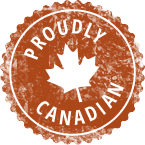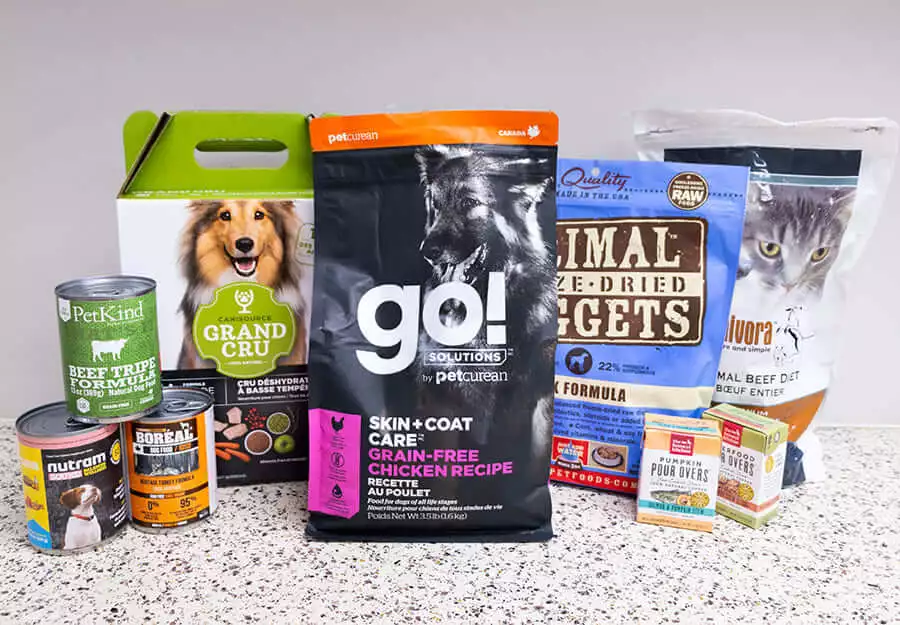
With so many options available, choosing the best types of dog food for your pooch can sometimes feel like finding a needle in a haystack. There are so many choices, and on paper they all sound great, but how can you tell which food is the right one for your dog? What kind of dog food is best?
Before you can pick a brand, you need to know the benefits of the different options available to you. We recommend checking out our Dog Food Guide to learn how to identify some of your dog's unique dietary requirements and tips for finding the best food for them.
In this article, we will look into a variety of feeding formats so you can understand which type or combination of foods will most positively affect your dog's health.
What is Dry Dog Food?
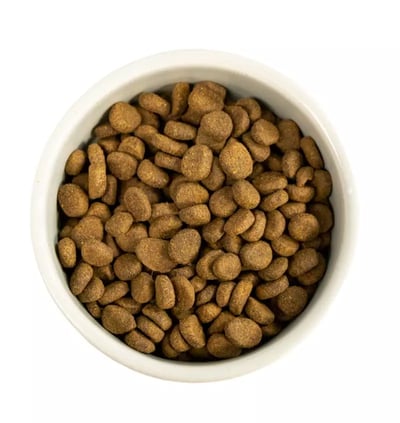
You are probably already familiar with kibble dog food, but knowing what it offers and how it’s made may help you decide if it’s the right choice for your pet. Kibble is a style of dog food that contains all of your pet’s necessary nutrition and is ground, formed into pellets and cooked.
Being one of the most commonly fed food styles for pets, the variety of kibble formulas and processing styles are vast, but the final products yield similar benefits.
Kibble was the first type of commercial dog food ever produced, and it was produced for convenience.
While the original ‘kibbles’ are unrecognizable from what we see today, the core concept has remained - to provide complete nutrition, including meat, carbs and essential vitamins and minerals in an affordable and easy-to-feed format.
Benefits of Dog Kibble
A kibble diet is no longer intended to just feed dogs but to nourish them and help them lead long, healthy lives. Awareness of canine nutrition and the demand for higher-quality diets have produced convenient, complete kibbles that can provide a full spectrum of nutrients.
Here are some benefits of feeding kibble and the reasons why it still remains one of the most popular types of dog food.
Convenience
The main benefit of feeding kibble is still convenience. Compared to other formats, dry dog food is typically much cheaper and easier for pet owners to handle.
Just scoop, serve and forget about it.
When we are buzzing around trying to keep up with life, kibble makes it easy to confidently feed your pets high-quality nutrition without the fuss of other types of diets.
Dental Care
Kibble can support oral health. Bacteria can build up around the gum line and in between teeth, causing bad breath and more severe dental issues. Abrasion from chewing kibble can help remove some of the bacteria, preventing plaque and tartar buildup.
On the flip side, the sugars in kibble can feed bad bacteria in your pet’s mouth too. Kibble as a sole dental routine is insufficient. No matter the format, your pet's diet should always be paired with a regular dental routine to prevent dental issues.
For more information, check out our Complete Pet Dental Care Guide to learn different ways of caring for your pet’s dental health.
Shelf Life
The increased shelf life of kibble is also a selling factor. The best type of dog food can be left out for days without the risk of going bad, although fat is still present and can spoil if left in humid areas.
Once the bag is opened, the food can last for months without going bad, assuming it is properly stored.
Types of Kibble for Dogs
You may assume that all kibble is the same, but how the kibble is manufactured can provide different benefits. This variety makes kibble more versatile and allows you to find the dry dog food that best suits your dog's unique dietary needs.
Traditional Extruded Dog Food
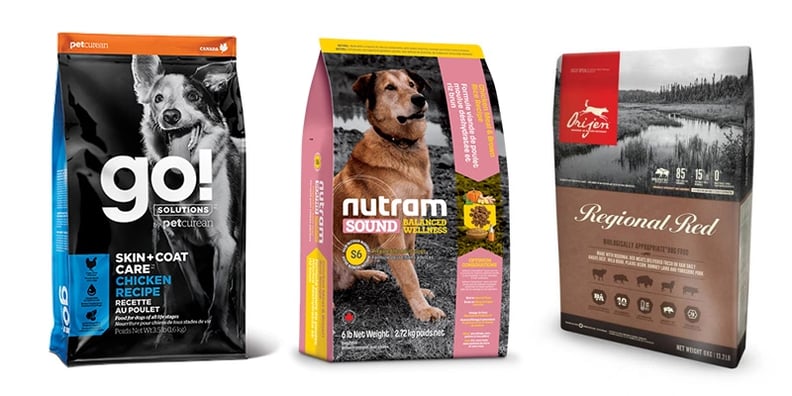
This standard type of kibble manufacturing is done by grinding and mixing the ingredients into a dough and then pushing it through a machine to form a cylinder that is then cut into pellets before cooking.
The pellets are cooked at high temperatures and coated in fat, vitamins and preservatives to prevent spoilage. While the preservatives don’t sound too appetizing, they are required to provide the long shelf life that we expect of our pet's food.
The extrusion process, requiring high-heat cooking methods, damages the nutrients in the food, so additional vitamins and minerals must be added after extrusion to maintain complete nutrition.
Baked Dog Kibble
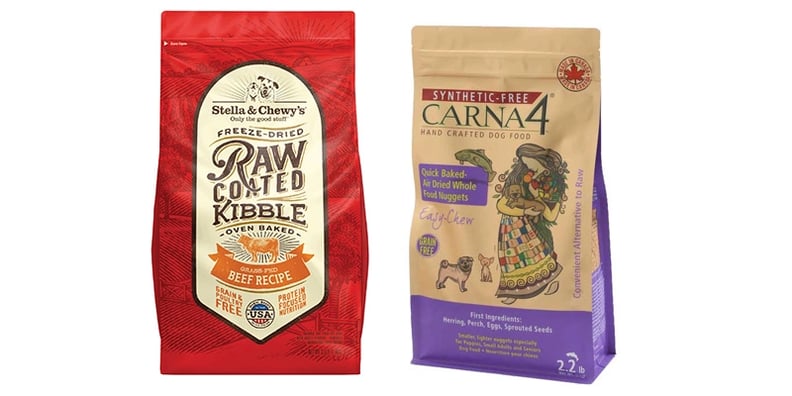
Baked kibbles are cooked at a lower temperature, leaving a more nutrient-dense and flavourful kibble compared to extruded foods.
Baked kibbles can be a little more expensive and not as widely available but are an excellent option for kibble feeders looking for a more nutritious diet for their pets.
Additional benefits of baked kibble are improved digestion and a softer texture. Both of these are a result of the manufacturing process, which produces a less compressed and more porous pellet, allowing it to break apart more easily in your pet’s mouth and stomach.
Raw Coated Kibble
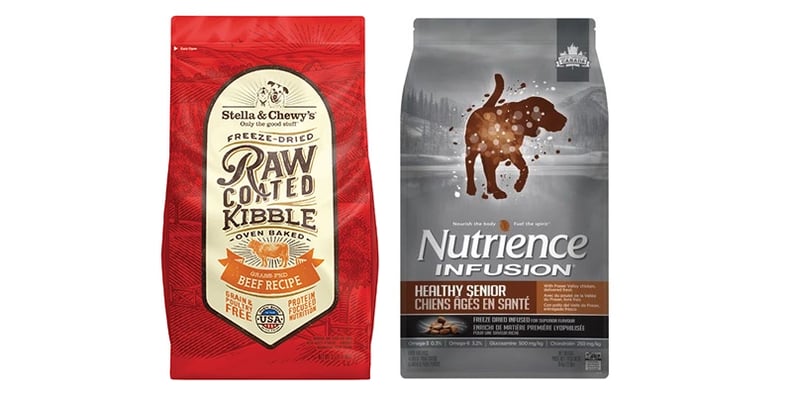
A unique variety of kibble is coated kibbles. Some brands have started using a freeze-dried meat coating on their kibbles.
This can be done for either baked or extruded formats, and it is typically added after the cooking process to provide the additional nutrients gained from the freeze-dried meat coating.
Coated kibbles are a great way to increase nutrition and add flavour, especially for picky eaters, and are usually in addition to vitamin and mineral premixes that are added to most kibble to fortify them.
As the most popular and common style of dog food, kibble has the most variety to suit dogs with specific nutritional needs. Whether you are looking for the best puppy food, the best large-breed food, or even the best dog food for weight loss, there are plenty of dog kibble choices that will do the trick.
What is Wet Dog Food?
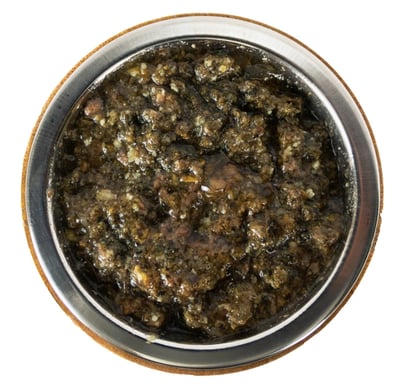
Wet dog food is another very common way to feed. This type of dog food uses similar ingredients to kibble and other dried foods for dogs, but the difference is in the cooking and packaging.
These diets are cooked at lower temperatures to retain moisture and are then packaged into cans to give the food a long shelf life.
Wet food is an excellent way to add variety to your dog's diet and ensure that they are getting the nutrition they need.
Benefits of Wet Dog Food
Canned foods are no longer limited to the standard metal can container. Pouches and Tetrapaks are offered for pet owners looking for a BPA-free option or are seeking a more environmentally friendly packaging choice.
There are many benefits to feeding canned dog food, but here are a few of the commonly known ones:
Better Taste
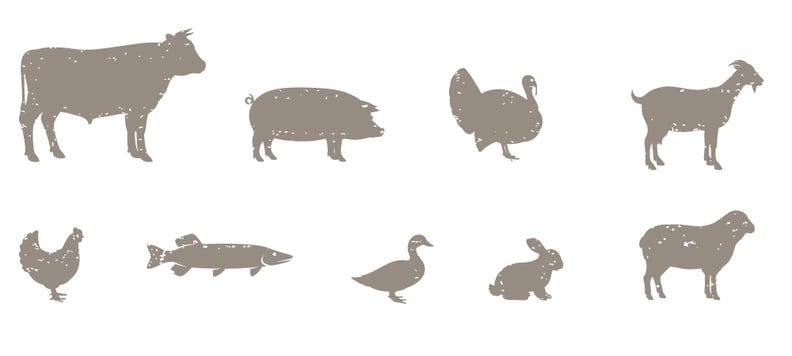
The most commonly known benefit of feeding wet foods is their palatability. Canned diets come in a wide variety of flavours and formulas to appeal to your finicky dog’s tastes and encourage regular and healthy eating habits.
Canned food can be fed alone or alongside dry kibble diets. The higher cost of canned foods often leads pet owners to feed wet dog food in addition to other diets.
More Texture Variety
The texture can increase palatability too. If your pet is being fussy, try switching to a flaked, shredded or stew formula to try to pique their interest.
For dog food types, canned diets can be fed as a complete meal, but be cautious about your pet's dental health. With no abrasion from chewing, many pets can develop severe periodontal issues.
If soft foods are being fed, it is vital that you incorporate regular dental routines like tooth brushing, chews or supplements like water or food additives.
Increased Moisture
A very underestimated benefit of canned diets is their moisture content. Although many dogs drink water throughout the day, it is still not enough.
Canned diets contain 70-80% moisture content compared to the average 10% in a dry kibble diet.
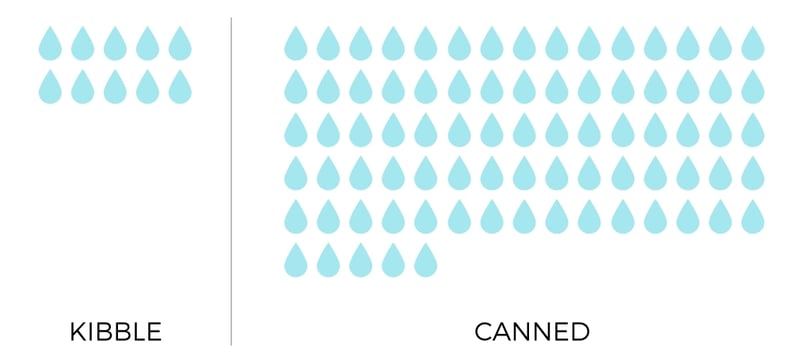
Your dog's body uses water for digestion, nutrient absorption and to flush waste from the digestive tract. Better digestion will allow your pet's body to process calories better, absorb more nutrients, burn fat, and build muscle mass.
Types of Wet Dog Food
Canning dog food is one of the oldest and most common ways to offer nutrient-dense and nutritious food for canines. This process provides a long shelf life and helps the food retain flavour.
But traditional canning isn't the only way to craft nutritious wet dog food. Here are the most common styles of wet dog food:
Canned Dog Food
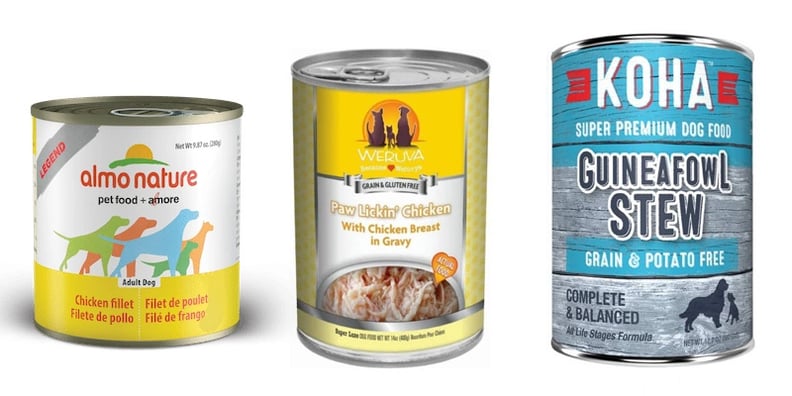
Traditionally, canned food for dogs is a mixture of fresh raw ingredients that is put into cans and then cooked. This process allows the food to retain its moisture and produce a strong flavour and scent.
The process of canning allows food to stay fresh and flavourful for long periods of time, and the individually sealed meals make serving and portioning simple.
Dog Food Pouches
Pouches are another style of wet dog food. These individually packaged diets offer smaller meals for easier portioning and less waste.
Additionally, the pouches are made from safer materials and are free from BPA and other chemicals that are needed to line cans to prevent the food from touching the metal can directly.
Tetra Packs
One of the newest ways to package wet dog food is in tetra packs. Similar to pouches, tetra packs are free from BPA and other chemicals but have the additional benefit of being more eco-friendly.
The containers are often made from a mixture of cardboard, polyethylene and aluminum making the packaging easier to recycle in certain facilities. While they are not biodegradable, they are a preferred choice for those looking to manage their carbon footprint.
Wet food is incredibly versatile and flavourful, making it a popular feeding format for dogs of all ages. Check out 13 Canned Dog Food Benefits for even more reasons to feed wet dog food.
What is Dehydrated Dog Food?
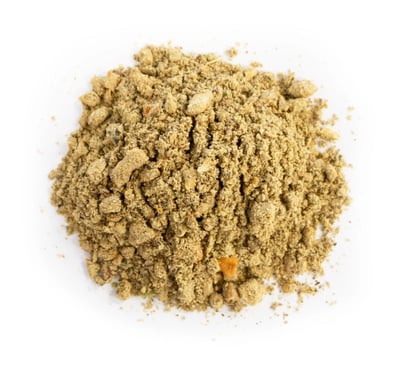
Some popular new formats of pet food are dehydrated dog foods. Dehydrated dog foods are either completely raw or gently cooked before the moisture is removed with low heat.
These foods retain more nutrients and flavour than kibbles and wet foods that have been processed at higher temperatures. While this may be a newer format for many pet owners, it does have some exceptional benefits.
The most common styles of dehydrated foods are meant to be rehydrated, creating a texture similar to wet or canned dog food. You can also find scoop-and-serve styles, like air-dried dog food, for those looking for a feeding experience closer to kibble.
Benefits of Dehydrated Dog Food
One of the biggest reasons that dehydrated dog food is so popular is that it's less processed than kibble and canned dog foods, so you end up with a more natural diet that is easier for your dog to digest.
By using low heat, the food can be dried with minimal damage to the ingredients and nutrients, leaving a fresher and more nutrient-dense diet for dogs. Here are a few big benefits of dehydrated dog food:
No Fillers
Dehydrated diets are often more meat-focused than kibble because ingredients like grains, legumes, and potatoes are required to provide the texture of the food.
These lower-carb diets are great for weight management and building muscle and can be a helpful tool when managing sensitive tummies and dog food allergies.
Optimal Digestion
Similar to canned diets, dehydrated formulas are easier to digest than kibbles. Feeding dehydrated foods is often a great choice for those looking to incorporate more fresh ingredients into your pet’s diet.
Natural sources of vitamins, minerals and other nutrients are easily utilized by your pet’s body. If you are interested in checking out some best dehydrated dog foods, here are some brands that we love:
Types of Dehydrated Dog Food
There are two types of dehydrated dog foods to choose from, depending on your dog's preferences and how you like to feed:
Ready-to-Eat Options
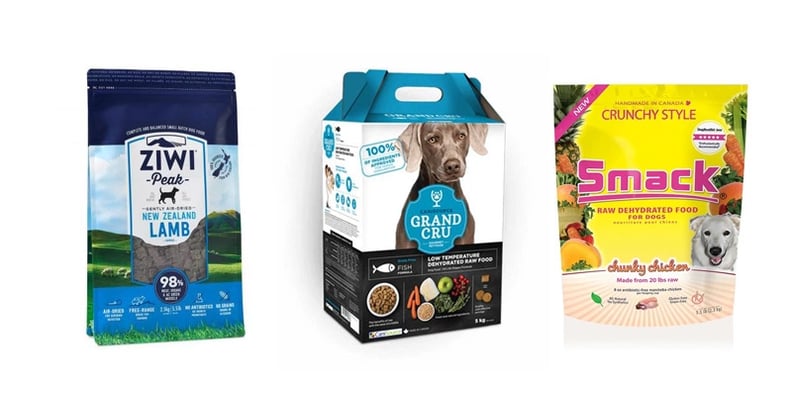
Crunchy-style diets are an easy alternative for pet parents who are on the go and don’t have time to portion and weigh out their dog’s food. Just scoop and serve, similar to kibble.
This format will have a higher moisture content than kibble, but not by much. If your goal is to increase moisture content in food, then this food format may not be the solution you are looking for.
Air-dried dog foods are a newer and alternative style of dehydrated dog food. Using no heat to dry the food, air-dried dog foods retain even more nutrients and are closer to the nutrition of raw dog food.
Just Add Water
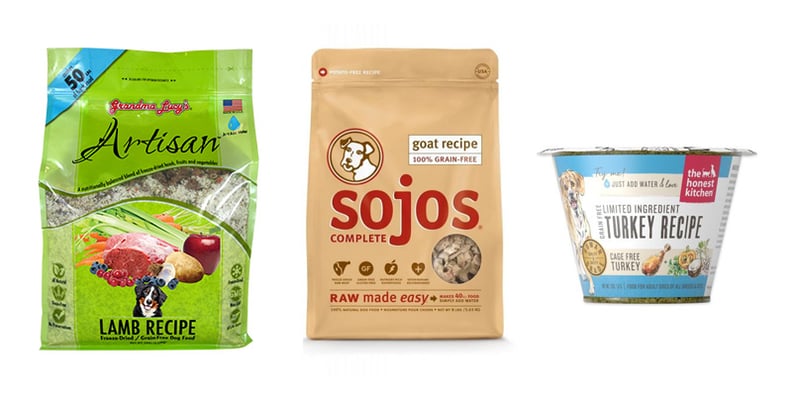
Many dehydrated foods require you to add water. They will typically be finely ground, flaked, or have a coarse granola-like texture. Once hydrated, the foods will look similar to wet dog food.
It is easy to store and feed and can even be taken on the go for camping and vacations and prepped when needed.
The nutrition between the two styles is similar, but adding moisture is always an advantage, so this style of dehydrated pet food is often preferred for those looking to feed as close to raw dog food as possible.
What is Freeze-Dried Raw Dog Food?
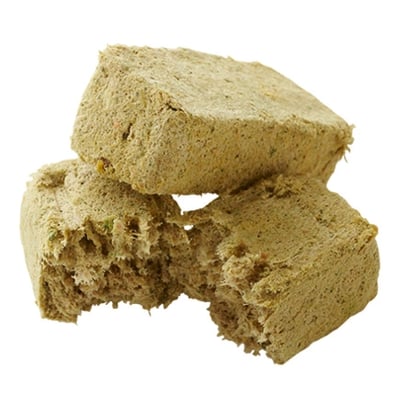
Freeze-dried raw diets are a form of raw feeding that is gaining popularity. While they offer many of the same nutrients as raw dog food, the moisture has been removed, and the product has been pressed into small pucks, patties or pellets for easy storage and feeding.
They are not truly raw, in the same way that fresh raw dog food is, but they are very close and offer many nutritional benefits that cooked dog foods lose during the manufacturing process.
It's also important to note that not all freeze-dried dog foods are made from raw ingredients. Some diets, like Grandma Lucy's, are gently cooked before freeze-drying. These diets are a good option for those looking for raw nutrition but are cautious about handling the bacteria in raw dog food products.
Benefits of Freeze-Dried Dog Food
Freeze-dried dog food is quickly growing in popularity because dogs love the taste, and owners love the nutrition that it provides. Here are some of the reasons why many pet parents are starting to add freeze-dried dog food to their pet's meals:
Moisture Rich
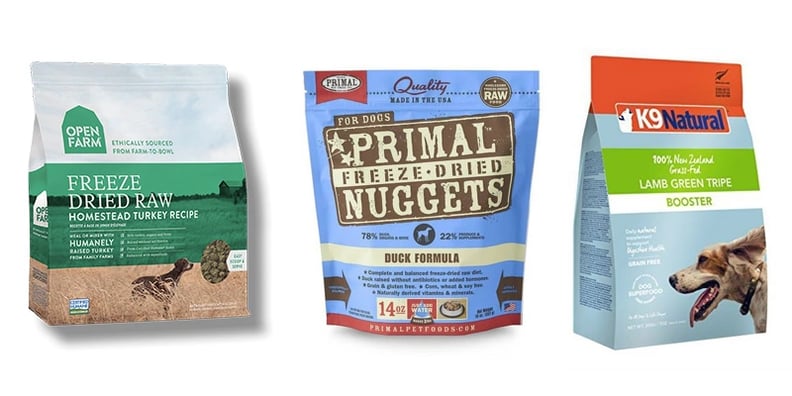 Similar to raw and canned foods, freeze-dried pet food is designed to add moisture to your pet’s diet. Freeze-dried diets will be finely ground, leaving a texture similar to canned food once rehydrated. This texture is very palatable for picky dogs and soft enough for young puppies and senior dogs.
Similar to raw and canned foods, freeze-dried pet food is designed to add moisture to your pet’s diet. Freeze-dried diets will be finely ground, leaving a texture similar to canned food once rehydrated. This texture is very palatable for picky dogs and soft enough for young puppies and senior dogs.
Freeze-dried raw diets must be rehydrated. Otherwise, they will absorb moisture from your dog, resulting in dehydration and possible bloat.
Travel and Convenience
Freeze-dried foods are ideal for travel, vacations, and camping. It’s lightweight, easy to store and can be made to order by simply adding water.
It’s also a convenient option for raw feeders who aren’t willing to give up their precious freezer space for their pet food.
Conveniently, freeze-dried can also be prepped in advance and frozen for later use.
Meal Toppers and Treats
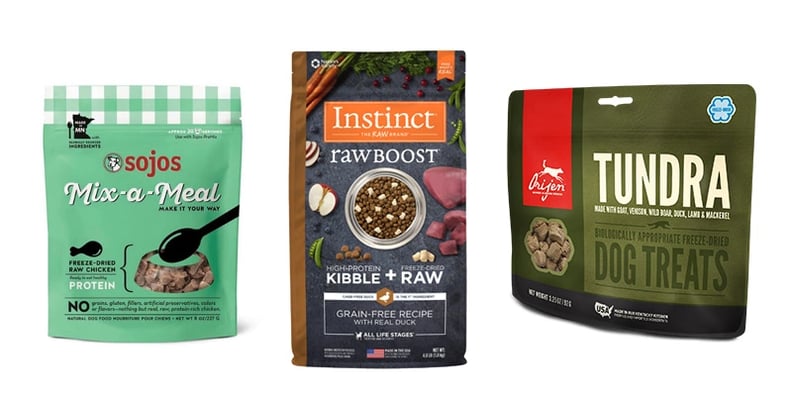
Complete meals aren't the only use for freeze-dried diets. You can crumble small pieces of freeze-dried foods into another diet to add flavour and nutrition, similar to a raw-coated kibble diet.
Keep in mind that if you choose to offer freeze-dried foods without rehydrating them, they should always be added in small portions. Up to 10% of the diet is a good target. Larger portions should always be hydrated.
Here are some of our favourite freeze-dried diets:
Freeze dried is a quickly growing category of dog food in Canada. You can choose from a huge selection of diets offering different protein sources, limited ingredients, high protein, and even life stage specific.
What is Raw Food for Dogs?
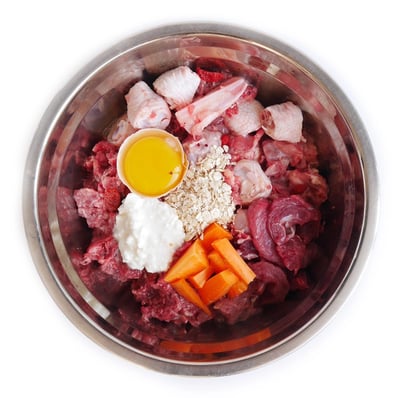
Raw diets are a popular feeding format in Canada. The core of the diet is in feeding foods that are minimally processed and unaltered by heat. This helps to preserve key nutrients, enzymes, and good bacteria that support your dog's overall health.
A well-balanced raw diet offers the most natural nutrition, similar to the diet of your dog's wild ancestors.
There is some variety in formula, but a complete raw dog diet will include meat, bone, and organs to offer a diverse range of essential nutrients. Many diets also include healthy sources of vitamins, minerals, and fibre like fresh fruits and vegetables.
Benefits of Raw Dog Food
Raw food for dogs is popular for a reason. It's natural and healthy, and dogs love the meaty taste. Dogs have many carnivorous traits, which is why a carnivore diet can help your dog thrive.
Not sure if raw dog food is the right choice for your dog? Take a look at the top benefits of feeding raw dog food below.
Easy to Digest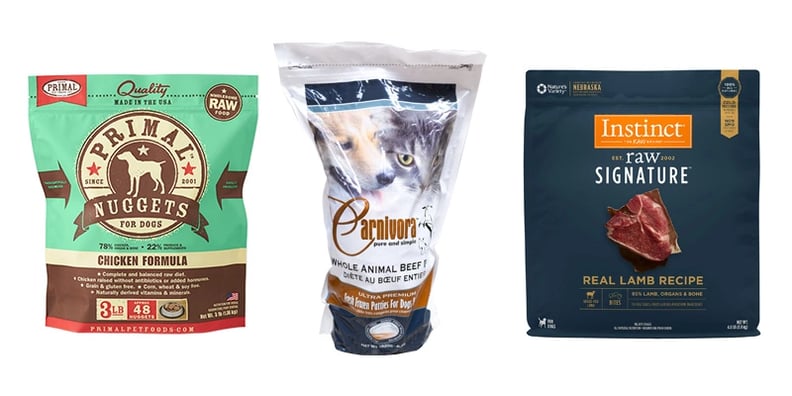
The bioavailability of an ingredient is how digestible and usable an ingredient is for your dog’s body. To learn more about bioavailability, check out Dog Nutritional Requirements.
The heat from processing can alter the composition of fatty acids, amino acids, and enzymes used to support many functions in the body.
Raw diets retain all of the nutrition from each ingredient in forms that your pet’s body can properly utilize. Synthetic vitamins and minerals added to cooked diets are often less available or aren’t digested as efficiently as those coming from natural, unprocessed food sources.
Less Waste

For pet owners who have never fed a raw diet before, the difference in stool quality can be quite remarkable. Commercial diets, being less bioavailable, create more waste. The result is a larger, more odorous stool.
With a raw diet, very little is wasted during digestion, so everything that is excreted is broken down into a completely biodegradable form. Fast decomposition will leave practically no backyard cleanup.
Dental Health Benefits
Enzymes in raw meat provide superior dental benefits compared to the abrasion from chewing kibble. These enzymes work by combating bacteria in the oral cavity that can cause dog breath, plaque and tartar buildup, inflammation of the gums, and the potential for other serious dental health issues.
These benefits do not omit the need for regular teeth brushing and dental care, but they will prevent rapid bacteria buildup in the mouth.
Skin and Coat Health
Raw, unprocessed ingredients contain higher, unaltered sources of omega fatty and amino acids than processed and cooked ingredients. These essential nutrients are vital to maintaining your dog's healthy skin and soft, shiny coat, as well as a variety of your dog’s other internal systems.
Raw feeders typically see improvement within weeks of switching to a raw diet, including reduced shedding and less dander.
Want to know even more about feeding raw dog food? Hop over to Raw Dog Food for Beginners for more benefits, safety tips, and the best ways to feed raw food to dogs.
Every Pet is Different
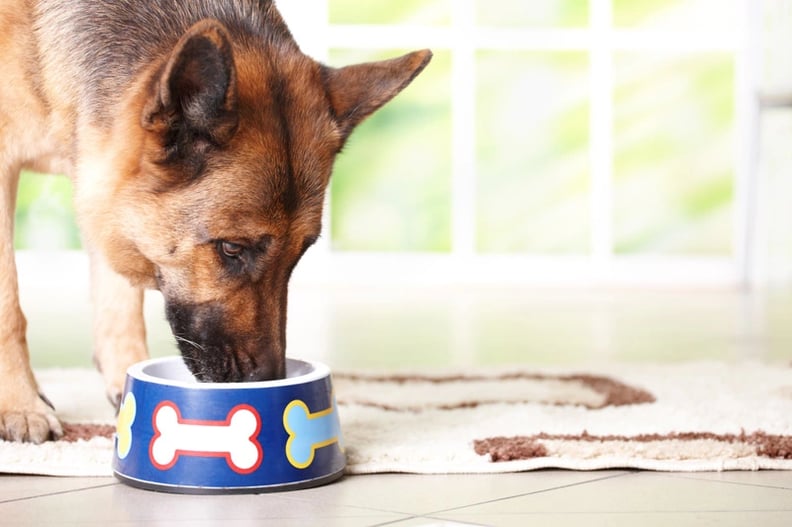
So we've been over our choices of dog food types, but which one is right for you and your pet?
Well, fortunately, your dog will probably do well on any format of dog food.
Raw dog food has so many health benefits, but it's not right for every dog or owner. It can get quite costly depending on what size and how many dogs you are feeding, and it requires a lot more prep time than other diets.
If raw isn't the right choice for you, then we recommend a mixture of foods. Each has its own benefits and pitfalls, but together they are stronger than they are apart.
With a proper dental routine and an active lifestyle, your dog can thrive on just about any diet format, as long as you are choosing high-quality, biologically appropriate ingredients.
Frequently Asked Questions
What is dry dog food, and why is it a popular choice?
Dry dog food, commonly called kibble, is a convenient choice because it has a long shelf life and can help maintain dental health by reducing plaque buildup on your dog's teeth.
What are the benefits of feeding wet dog food?
Wet dog food is high in moisture content, making it a good choice for dogs who need extra hydration or have dental issues. It can also be more appealing to picky eaters.
Are grain-free dog foods healthier for my pet?
Not necessarily. While some dogs benefit from grain-free diets due to allergies or sensitivities, it's essential to consult with a veterinarian before making dietary changes, as grain-free diets have been associated with certain health concerns such as heart conditions in some breeds.
What is raw dog food, and is it safe for dogs to consume?
Raw dog food consists of uncooked ingredients like meat, bones, and vegetables. It can be safe when prepared and handled properly, but there are potential risks of bacterial contamination, so consult your vet before switching to a raw diet.
How do I choose the right dog food for my puppy?
Pick a high-quality puppy-specific formula that meets their specific nutritional needs, including essential nutrients like DHA for brain development.
Can I mix different types of dog food, such as dry and wet?
Yes, mixing dry and wet dog food can provide variety and offer the benefits of both types. Just ensure the total daily calorie intake aligns with your dog's needs to maintain a healthy weight.
.png?width=200&height=66&name=logo%20(1).png)






.jpg)

